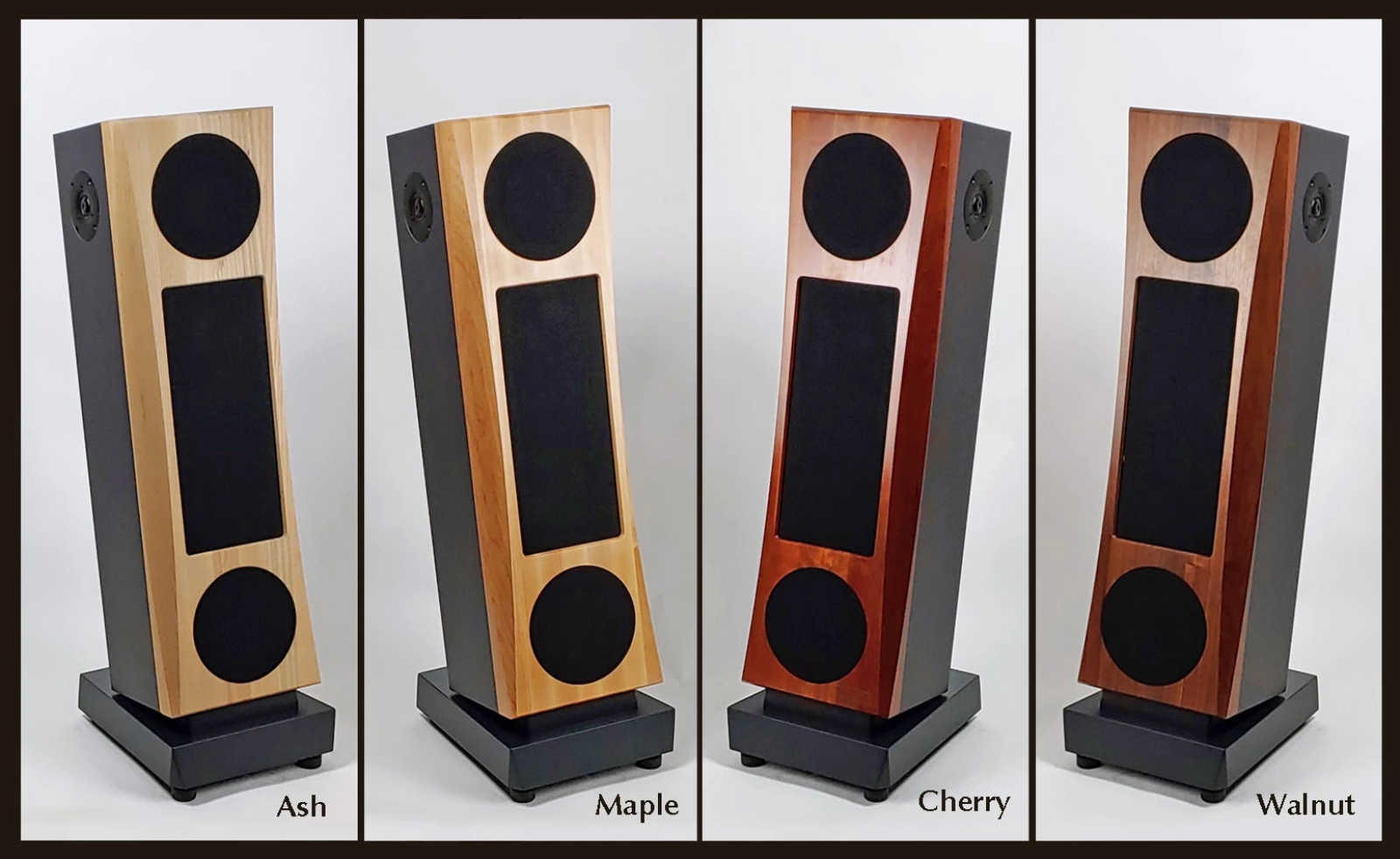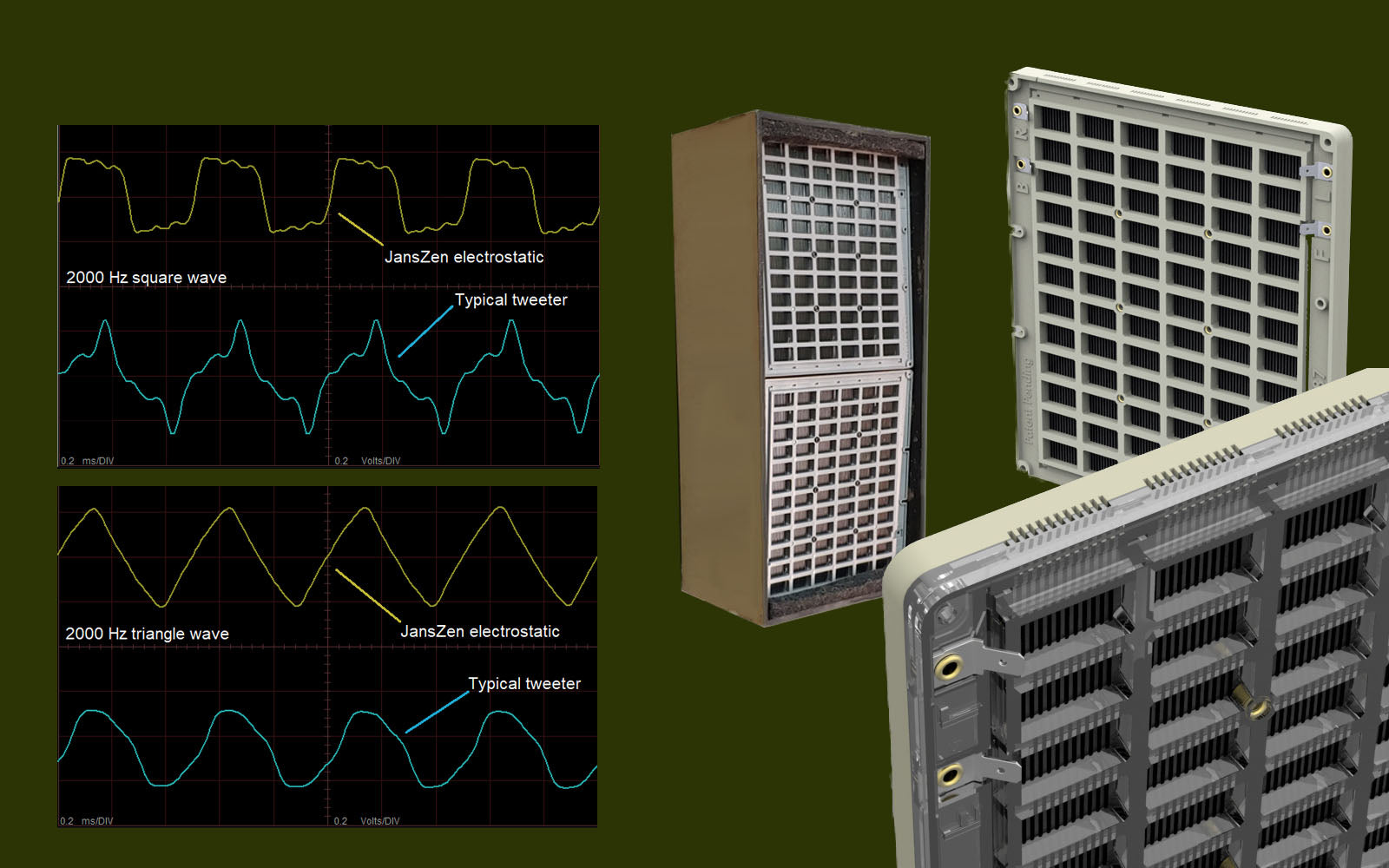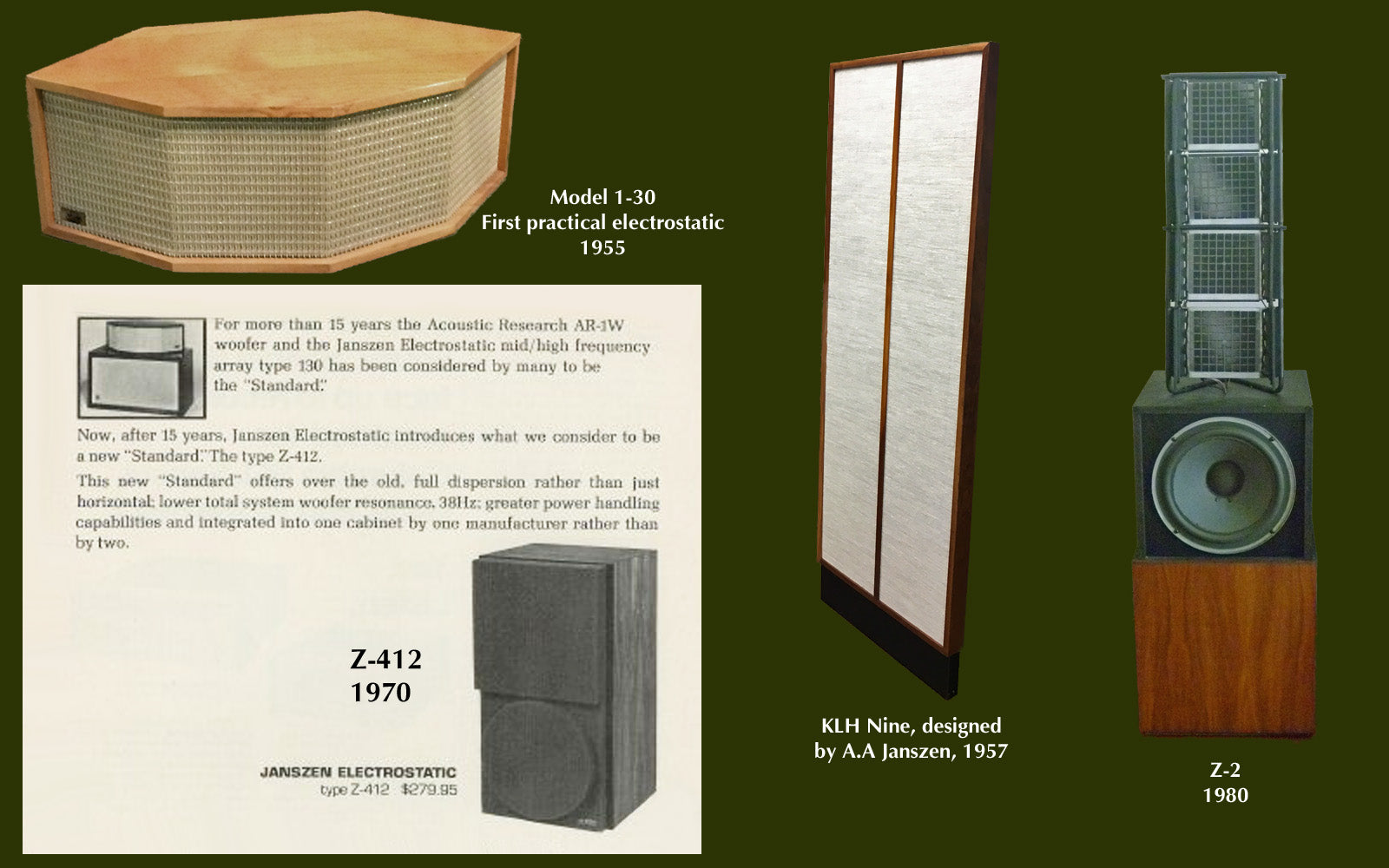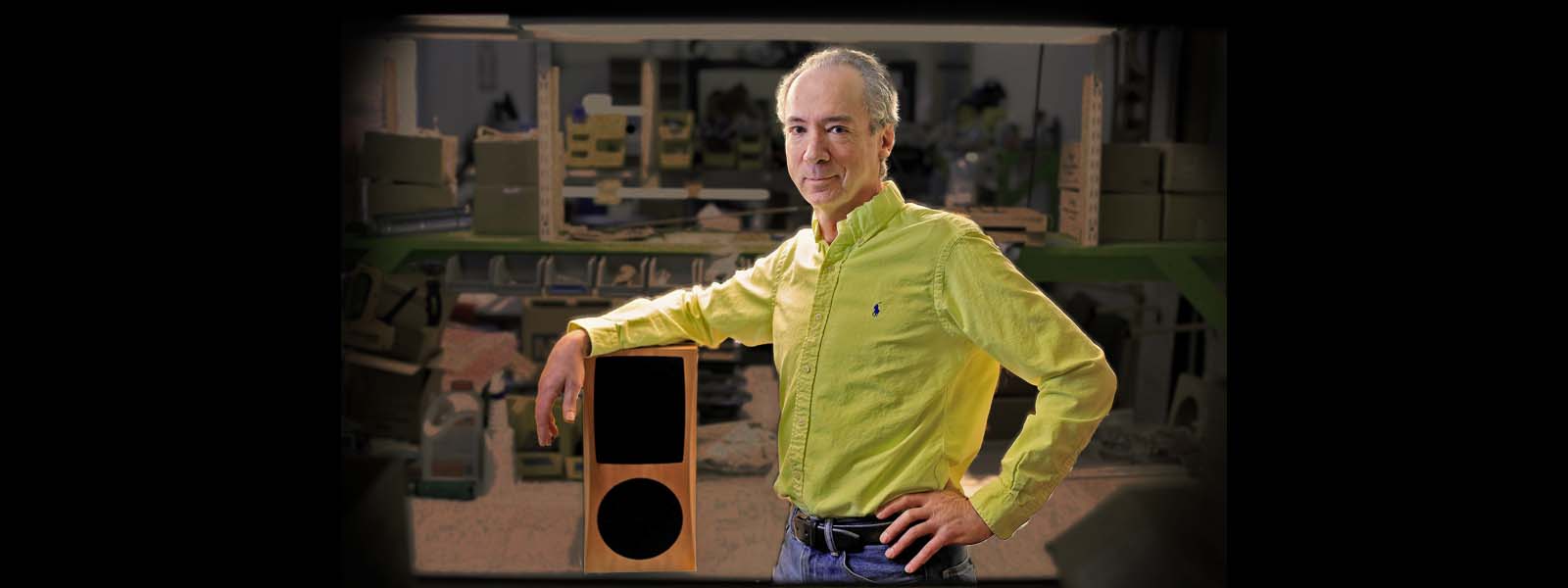
Do you look forward to being dazzled every evening by an aria or piano concerto? Or is your thing jazz riffs that have you bobbing your head? Or is bodacious rock the spirit that moves you?
Or really, is it all of the above and more?
If so, you might have found that most loudspeakers truly shine on only one or two genres, or at only one loudness level. It's rare that any loudspeaker can make every genre come to life at any volume level with impeccable nuance, force, and clarity.
We've gone to extreme lengths to create loudspeakers that do just that.
The absolute immediacy and transparency of electrostatics are the foundation of this versatility. Whereas conventional loudspeakers deliver music through heavy, complex drivers, sound just flows effortlessly through JansZen's ultra-light, ultra-simple electrostatic drivers.
With no voice of their own, they serve as open windows into your recordings, leaving the music exactly as it was recorded. Immediate. Pure. Intoxicating.
contact us
Musical instruments make sound by vibrating the air in all kinds of wonderful ways. The challenge for loudspeakers is that they're supposed to imitate that whole range of musical expression in just one way, by vibrating diaphragms. Convincing execution of this imitation is only possible when those diaphragms are so light that they essentially disappear.
The only loudspeakers with such vanishingly light diaphragms are electrostatics, and the only way to vibrate such light diaphragms is with electrostatic force.
Electrostatic diaphragms are thinner than 1/10th of a human hair, making them lighter than the air they vibrate against. Wispy, virtual air barriers make the sound, rather than heavy, complex, vibrating mechanisms.
You can read more here about what makes lightness matter, and here about how conventional loudspeakers distort the sound. The TECHNOLOGY menu above also has further information about how electrostatics work.

In JansZens, electrostatics cover the midrange and treble, which is where the magic is. To that essential magic, we add the satisfaction of deep, clean, punchy bass by way of fast, low distortion, seamlessly integrated woofers.
At this point, you're probably wondering, if electrostatics are so great and cones are not, why do we use cones for the bass? Well, first of all, making deep bass and palpable impacts is not a delicate operation. At least in our case, woofers must execute a tricky combination of grunt work and nuance, and getting it right depends on which woofers we use and how we use them.
The first thing is for the woofers to act as solid pistons, even though they're not made that way. Nowadays, the best woofers can do that, as long as they're not asked to make sound above bass frequencies, where they'd break up, nor pushed beyond their linear excursion limits, where they'd make noticeable distortion. Our crossovers are set at a very low 500 Hz (just above middle A), so not only is all the tricky stuff on our high purity electrostatics, but our woofers are as free of breakup coloration and distortion as those electrostatics are.
To attain our famously undetectable transition between the two types of driver, we do employ a few tricks, as well as use the best woofers for this sensitive job. We also have ways of getting deep bass from our compact, sealed enclosures, without employing transient-wrecking ports.
Between the low distortion, the lack of coloration, the seamless integration, and our careful attention to crossover design, the woofers give no clue that the entire loudspeaker isn't electrostatic.
contact us
Good looking, easy to place, and musically transportive
Last but not least, the attractive cabinets suit a wide range of decor, so arbiters of household furnishings tend to welcome them into the home. They're also easy to place, partly because they don't emit the space-demanding back wave that dipolar electrostatics do.
These loudspeakers have controlled dispersion, which means the sound projection is narrow enough to cut way down on wall, floor, and ceiling splash, yet wide enough for a few people to sit together and all get about the same sound and imaging,
Controlled dispersion without "beaming" is rare. It minimizes the amount of sound that would otherwise be bouncing around the room, and does so without making you sit in just one exact spot. This reveals an enveloping sense of the original spaces where recordings were made. This sense of space gives you a convincing you-are-there experience, and you'll probably find the feeling of being transported to the sites of original performances is a new thing for you.
The minimal room interaction also reduces the need to prioritize living space considerations over acoustics. Room treatments and furniture arrangement are thus relatively unimportant, although of course they do matter for optimum performance, as with any speakers.
If you're a woman, you may be glad to know that the critical range of frequencies, where conventional speakers tend to sound harsh, is instead as smooth as silk. This is because that range (1 kHz – 3kHz) is on the electrostatics, which are incapable of making peaky sound.
With JansZen hybrid electrostatic loudspeakers, you get the best of big electrostatic performance, without the usual drawbacks, plus the deep bass and concussive dynamics of a traditional loudspeaker, all in a deceptively compact, space-saving design. Audiophiles will especially appreciate the deep, wide soundstage and the realistically sized instruments floating above the speakers.
The advent of JansZen hybrid electrostatics means there's basically no reason left on Earth for anyone to live with the drawbacks of conventional loudspeakers or accommodate the space requirements of full range electrostatics.
As many satisfied music lovers have discovered, a pair of JansZens can fulfill your quest for musical authenticity and consistent enjoyment, and still satisfy the general preferences of the rest of your household.

Stand-mounts, too
Our stand mount loudspeaker is called the Carmelita, starting at $4850/pair.
Both the Valentina floor-stander and the Carmelita stand-mount are available in passive or active versions. Both models are compact at only about 40" [1m] tall. Both have the sonic hallmarks of much larger speakers. You might feel that having speakers that go all the way to the floor are worth the extra approximately $5000, but the sonic signature is practically identical, and the main differences are the bass depth, punch, and maximum loudness.
In both cases, the actives feature a high grade, on-board DAC and five independent inputs -- two analog and three digital. The analog inputs are sensitive enough not to need a preamp. The inputs automatically self-activate, based on which one has a signal, A remote control comes standard for volume and other functions. The Valentina A8 is bi-amplified with two 500W/4Ω Hypex NCore amps in each cabinet, and the Carmelita A7 has two 250W/4Ω Hypex Ncore amps is each cabinet.
If convenience and simplicity are your thing, imagine eliminating your amplifier, preamplifier, DAC, and speaker cables, all at once, and getting exquisitely clear and natural electrostatic sound, all for a modest premium of $3000/pair (Carmelita) or $3500/pair (Valentina). If you currently own JansZen passives, either model can be upgraded to active for those amounts plus a bit.
There's a new special option available on the Valentina, called Sound Everywhere (SE). You get real-time, remote control selection between directive vs. omidirectional sound dispersion. In the sweet spot, the difference is between a you-are-there vs. a they-are-here experience. In omnidirectional mode, the sound is uniform throughout the room, so you still get great sound when you're not in a listening seat. The SE option can be added to Valentina A8 loudspeakers as a factory mod.
contact usHOW WE DO IT
The keys are:
- technology
- an emphasis on live sound in real rooms
- careful listening
JansZen invented and patented the first practical electrostatic speaker in the early 1950's. Our modernized electrostatic transducer technology is the basis for delivering incomparably natural midrange and treble, while fast, ultra low-distortion woofers fill the room with deep, commanding bass and concussive drum impulses. These loudspeakers also project a detailed image across a soundstage that's strikingly wider, deeper and taller than the speakers, thanks to controlled dispersion and high phase accuracy. Beyond all that, JansZen loudspeakers create an impressively dynamic sound field that belies their modest size, thus contradicting the supposedly dainty character of electrostatic speakers. Top to bottom, their exceptionally high clarity, rounded fullness, and silky smoothness carry you to unexpected musical horizons.
For more information, have a look at the pages under the TECHNOLOGY menu above.
Electrostatics without the drawbacks
You've probably noticed that electrostatics aren't common. That's because they're hard to implement, despite being simple in principle. In addition, they've got to meet modern standards of performance and reliability, while also well suiting home environments. It's a tall order, but JansZen, being the company that invented and brought to market the first practical electrostatics in the 1950's, has a leg up on all that.
Our compact, closed-back (non-dipole) designs disprove every criticism of electrostatics we've ever heard. These loudspeakers are reliable, solidly built, beautifully finished, easy to set up, require minimal space, and can rock with the big boys, all without losing that natural electrostatic nuance and inner detail on complex, serious music.
The legacy
All modern JansZen Audio products extend the technology of David Janszen's father, Arthur A. Janszen, inventor of the first practical electrostatic transducer in the early 1950's. For the last 15 years, David has been at the helm, developing new designs and making them available to discerning music lovers worldwide.
Built to order
JansZen loudspeakers are individually hand crafted to order by attentive artisans in our Columbus, Ohio workshop.

Valentina
The Valentina is our flagship. We build these exceptional electrostatic hybrid speakers to order in both passive (P8) and active bi-amplified (A8) versions.
The front baffle is 2.5" of solid walnut (shown), or cherry, maple, or ash. Painted finishes are also available. At only 38" tall, with two 8" woofers and two electrostatic panels, they fill a room with sound like much larger speakers.

Carmelita
The Carmelita is our stand-mount speaker, with performance that vastly exceeds its diminuitive size. We build pairs to order in both passive and active versions, with or without integral, vibration isolating stands. The 1" thick cabinet is veneered in figured walnut, cherry, or maple (shown).

Lotus
Coming by Winter 2023 Pre-order now and save 10%. $1495 list price; $1345 promotion price - save $150 by pre-ordering.
Unlike other electrostatic headphones, the Lotus will go anywhere that you go, thanks to being completely self-contained. They'll even play from just a cell phone or portable player. There's no interface needed. This is a world's first. Final prototype shown.
Testimonials

About the Valentina A8:
"The clarity and imaging of the JansZens is outstanding. The images had excellent depth, and the presentation was effortless, with no sign of strain. In this position [sweet spot], the image is almost holographic. However, the speaker sounds wonderful no matter where you sit. In my room, the bass is solid to the high 20’s, and there is absolutely no discontinuity between the midrange and bass. This seamless integration holds even at a volume high enough to be uncomfortable. In short, the speakers felt as if they had limitless dynamics coupled with very low distortion."
Full review posted to AudioCircle
— rfertel, 20 May 2020

About the Valentina P8:
"The original wonderful sounding but bass shy zA2.1 Valentina has had an impressive upgrade. Slam, bang, these woofers are delivering the goods. I have always considered these among the sweetest sounding speakers I’ve ever heard with very few short comings. With the most significant short coming removed, they are the sweetest and complete full range speakers I’ve ever heard."
Full review posted to the Audiogon Forum
— Lance E., October 2019

About the original Valentina Active:
"I love it!
"Lol, it's been a journey to get to this spot in listening pleasure, I still have a room mode to crush but these Active Valentina's are a pure joy to listen to. I can now understand why some who listen to Electrostatics won't go back to standard driver designs.
"The thing I love best about the Janszens is how resolving and fast they are when complex Orchestrated passages are run through them. They present the sound in a beautifully layered ethereal form as ethereal as the notes move through the air at a live large concert hall or orchestra pit, all in my little room as long as the recording is good."
— Brian H., November 2017
Florida Audio Expo attendee remark on Audiogon Forum about the Valentina A8:
"Lance, I never post here on Audiogon, or at least not for years, but I just posted a lengthy Capitol Audiofest trip report on another audio site and may post it here as well. The Janszen room was my favorite, and the only other room I thought was outstanding was the Genesis Maestro room.
The Janszen active Valentinas were shockingly good and with built in DAC and built-in biamped 500watts of Hypex Class D (which I thought I would hate...) nothing came close at $12,750... again for the whole system. It's unbelievable. I listened to many many rooms before coming to that conclusion. If I owned the JansZens, and I probably will as soon as I decide to make the investment, I would need about $50k for the whole Genesis Maestro system before I considered an 'upgrade'".
— Marco P., November 2019

About the Valentina A8, in heavily treated room, referring to playback of Mahler's 8th:
"I'll close by again telling you how amazing it seems to me when flutes play alongside soprano and they sound so natural and smooth all the time. Add in violins playing in a high register at the same time, and the overall presentation is thoroughly realistic.
"These speakers are perfect right out of the box -- no tweaks needed. That is the right way to do business, in my view: completely satisfy the customer's need on the first try.
"Attached PDFs show me selling my power amp and buying more music featuring soprano and flutes."
— Michael H., August 2020

About the original Valentina Active, paired with a subwoofer:
"In fact, the zA2.1a often makes instruments sound like 'the real thing.' By that, I don’t just mean that the tonal balance of instruments seems correct. Rather, I also mean that I can easily hear the way that sound resonates in and emanates from the bodies of instruments and vocalists.
"Another friend, who has long held that quality of reproduction has no impact on his enjoyment of the music he prefers, recently dropped by with a few CD’s in hand. About 15 seconds after I started playing his first CD, he turned to me and said, with a smile, 'Thanks for ruining my life.'”
— Barnet F., March 2016
Discussion thread about the second professional review of the original Valentina Passive (zA2.1):
"As another happy customer of these speakers I am thrilled to see this review. It has stressed the most important design elements of this speaker, the most notable for me being the perfect flow between the ESL panels and the woofers. The ESL panel qualities are almost a given, unless the designer doesn't know what he is doing. This is not a problem for the Janszen family. Making a hybrid ESL not sound like a hybrid is the tricky part, and these are the best I've heard in that department."
— jsm, August 2013
Discussion thread about an owner's in-home demonstration of the original Valentina Passive (zA2.1):
"I must say I was extremely impressed with the JansZens; powered by two Parasound A1 mono blocks, they were lightning quick, fluid, and displayed a cohesiveness typically only found full range drivers (the JansZens are two-way).
Although relatively modest in stature (I'm estimating 3' tall) the JansZens projected an image that more than filled his 17x20 room. Upright bass (my personal 'litmus test' so to speak) sounded magnificent and dead on the money."
— Green Lantern, July 2014

About the original Valentina Passive (zA2.1):
"The JansZen zA2.1 is a sublime design. First, the ESL panels are monopoles in sealed substructures that eliminate the panel's natural backwave. This improves transient responses and allows for cabinet placement flexibility. These do not need to be way out into the room although they will work this way just fine. The monopole approach takes away the comb filtering issue with dipoles. The ESLs are super and the latest design from the Janszen family. The speakers are modest in size, just over 3' tall on the bases but can play with good volumes. They will not shake the house however if massive volume is your thing. If amazing realism and great tonal balance is, keep these in your sites."
— jsm71, July 2013
Forum review of original Valentina Passive (zA2.1):
"Personally I believe David must be either a wizard or a genius. He has created something unlike any speaker I've ever heard. First, contrary to other hybrid speakers I've heard, I cannot find any sonic clue where the crossover occurs between electrostatic and cone, it is absolutely seamless. Next David damps the back wave from the electrostatic mid/tweeter, so it is not a dipole. This makes room placement much easier and avoids the need for placement well out into the room. That along with the size must rate high on the WAF scale. Yet somehow, even without the dipole projection this speaker is very spacious and presents a large and deep soundstage.
As Quad lovers will testify, loud playback levels are not the typical forte for electrostatics. All I'll say here is the Janszens will play back louder than I'd ever care to listen. Then there is the bass. Not only has he blended it so well that it is seamless but the quality and impact from the bass is simply amazing for two 7" drivers per channel. A friend brought over his Phonic RTA and after taking a measurement with pink noise proclaimed it to be as smooth a frequency response as ANY system he has measured, including usable bass response down to 31 Hz." JansZen's comment: Note that this model has since then been revised with larger (8") woofers, giving even deeper bass and more palpable impact.
— M3 Lover, November 2013
Additional info and ordering
Because JansZen loudspeakers are built to order and have optional features, and the delivery time depends on the number of orders in our build queue at the moment, on-line ordering is impractical.
Our on-line store can be used, however, to get pricing.
For more detail, just give us a call or drop us an email. Once your questions are answered and your preferences known, we can give you a firm price that you can mull over, including shipping, cable lengths, wood species and finish, footer type, etc..
Newsletter
Sign up for articles by David Janszen about audio, plus the latest on new developments, show reports, and more…





